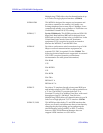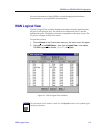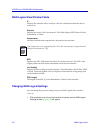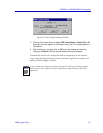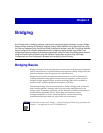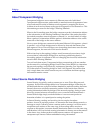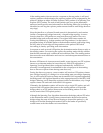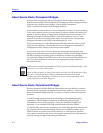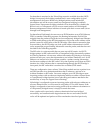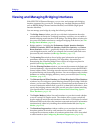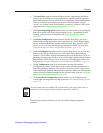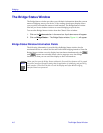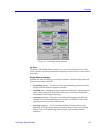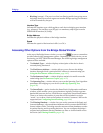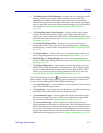
Bridging
4-4 Bridging Basics
About Source Route-Transparent Bridges
Because network topologies have developed in which bridges must be able to
handle network trafÞc from end stations which support source routing and others
which do not, a hybrid type of bridgeÑSource Route-Transparent
(SRT)Ñcombines elements of both bridging methods.
An end stationÕs network drivers can be conÞgured in software to use a bit setting
in the source address portion of a data frame to indicate whether the station is to
operate in a Source Route or Transparently bridged network environment. The
Routing Information Indicator (RII) bit of the source address is set to 1 if the
station is to use Source Routing; if the station is to operate in a Transparently
bridged environment, the RII bit is left unchanged (i.e., at 0).
Not all end stations in a Token Ring environment have network drivers which
support Source RoutingÑwhether the drivers are improperly conÞgured via
management or they simply are not source-route capable.
In a network with a mix of Source Route and Transparent end stations, data
frames from both station types must be bridged correctly. An SRT bridge inspects
the RII bit setting of incoming frames to determine whether they should be
Transparently bridged (if the RII bit was at 0) or Source Routed (if the RII bit was
set to 1) to their destination and will use the appropriate bridge method to
forward the frame.
About Source Route-Translational Bridges
Because SmartSwitch 2000, 6000 and 9000 modules have the ability to combine
mixed network topologies, yet another hybrid bridge methodÑcalled a Source
Route Translational bridge (SR-TB)Ñis used by a number of these SmartSwitch
modules.
An SR-TB bridge supports both Source Routing and Transparent bridging
capabilities, with the added requirement of maintaining Source Route
information across an FDDI interfaceÑeither the SmartSwitch 9000 FNB
backplane, or an installed FDDI High Speed Interface Module (HSIM).
An SR-TB bridge does this by ÒtranslatingÓ the Token Ring physical frame format
(by stripping out routing information, if necessary) so that the frameÕs source
address can be recognized on an FDDI, Ethernet, or ATM segment; and then,
when data is returned to the source, restoring the necessary route information to
forward it along a bridged Token Ring environment.
NOTE
Cabletron has extended the functionality of Ethernet ports on translational bridges, so the
ports can be set to Source Route mode.
When an Ethernet port is in Source Route mode, on receipt of an SR packet from a Token
Ring port, it will save the Source Routing information and send out the packet
transparently. When the response comes back, the source routing information will be
restored and sent to the Token Ring port.



